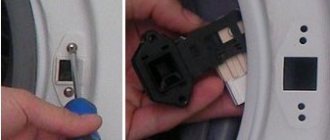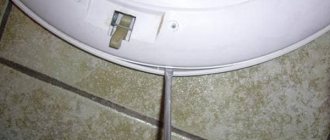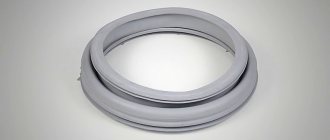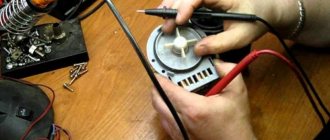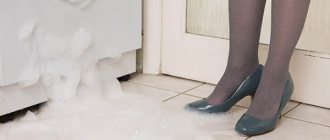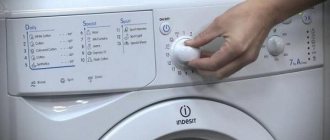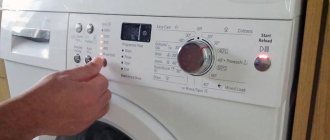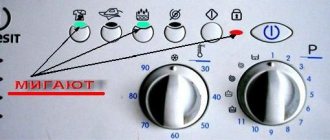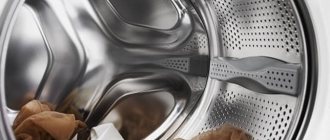External damage
The lock may not close due to normal wear and tear or rough handling. For example, sometimes wet things are hung on the door, which with their weight can damage the mechanism. Damage may also occur if the unit is closed with excessive force.
The device may not close for several reasons:
- As a result of prolonged use, the washing machine door was warped.
- The locking tab in the lock mechanism was misaligned.
- The plastic element or rubber gasket has worn out.
Identifying this type of fault is not difficult. To check, you can perform a test closure in normal mode, without loading laundry. If the door does not close under such conditions, it means that the lock has broken down or the fastening is skewed. Sometimes this may be due to improper installation, and then in an uneven position the hatch may warp under the influence of weight and vibrations. How to install a washing machine correctly - read here.
You can debug the operation of the machine yourself. Carefully inspect the device and locking mechanism. Check:
- Are there any objects preventing it from closing? Sometimes things can completely or partially fall under the hatch and jam the system.
- Condition of the locking hook: does it fit into the groove?
- Is the locking tab in place properly?
- Signs of peeling of plastic or rubber gasket.
Problems with the lock hook
The machine door is locked with a hook that ends the shutter rod. It is this hook that should fit into the socket and secure the structure. As a result of wear, vibration and other factors, the supporting rod may move out of its place and not fall into the socket at the moment of closing. The door may not close or may close without the door closing sensor operating.
The problem can be solved this way: dismantle the hatch door and unscrew it around the perimeter. Open the hatch parts, install the hook base in place and assemble everything in reverse order.
Hatch door sagging
The door frame is usually made of plastic. All fasteners (hinges) are made of metal. Plastic is softer than metal, and over time it wears out and deforms at the point of contact. As a result, the hatch door may sag, and as a result, the lock hook does not go where it is supposed to when closing. In such a situation, it is necessary to replace either the entire door or the fastening parts. This can be done using the following algorithm:
- remove the hatch door;
- disassemble it and replace damaged elements;
- put the door in place.
Over time, the hatch door may sag
Broken door handle
The assembled lock mechanism consists of the following elements: handle, lock hook, lock rod, spring. Breakage of any part results in the door not locking or closing/opening.
According to statistics, the door handle most often fails, since it is subject to the most active influence from the user. To replace any of the listed parts, you need to disassemble the entire door and replace the handle.
The most common thing to break is the hatch door handle.
To repair the handle:
- unscrew the door;
- disassemble it into components;
- remove the old handle;
- install a new part;
- assemble the door and install it in place.
We deal with the lock ourselves
You can deal with a broken lock at home with your own hands. It is not rational to immediately change the UBL - you should first make sure that it is faulty. The functionality of the blocker is checked using a multimeter.
To diagnose UBL, you need to remove it from the washing machine. The lock is located inside the machine, behind the front panel next to the door lock. To get to the device you need to:
- turn off the power to the washing machine;
- open the hatch door;
- find the outer clamp on the cuff and loosen it with a screwdriver or pliers;
- tuck the cuff into the drum;
- find the UBL (it is located in the place where the door closes);
- unscrew the two screws where the lock hook touches the UBL;
- disconnect the wiring connected to the device;
- remove the UBL from the machine body.
All of the above actions should be performed through the gap between the edge of the drum and the front wall of the washing machine. If the hole is too small, then you can try to reach the UBL from above. Remove the top cover and tilt the machine back. Then the tank will “unhook” from the end, and the hand will crawl to the blocker through the vacated 1.5-2 cm of space.
The next stage is testing the device. It is necessary to turn on the multimeter and measure the resistance at the UBL contacts. The main thing is to first study the electrical circuit of the blocker and find out where its phase, zero and general relay are located . Then we proceed like this:
- turn on the tester in the “Resistance” mode;
- we connect the multimeter clamps to zero and phase;
- measure the resistance (the norm is any three-digit number);
- move one of the probes from the phase to the common relay;
- look at the reaction of the multimeter (values “1” and “0” indicate a malfunction of the UBL).
The UBL cannot be repaired - only replaced with a new one.
If the hatch on the washing machine does not close, then the problem is in the lock, hinges, UBL or circuit board. To identify the cause and eliminate it, you will have to check everything from the list.
Interesting:
- The lock on the Indesit washing machine does not work
- The hatch of the Indesit washing machine does not close
- Dishwasher door won't stay open when open...
- LG washing machine hatch won't close
- The washing machine door does not close tightly
- The door of the Indesit washing machine does not close
Reader comments
- Share your opinion - leave a comment
Failure of the hatch locking device (UBL)
On the machine side, the process involves a hatch locking device (UBL). Its purpose is to lock the lock and not open it until the washing cycle is completely finished (all this time voltage is supplied to the UBL), thereby preventing unauthorized opening of the door and water spillage. The UBL can fail for two reasons: there is a breakdown in itself, or there is no voltage going to it.
The body of this device is made of plastic. The lock is locked under the influence of current, which simultaneously heats the mechanism. This leads to damage to the plastic and its deformation. As a result, the entire node becomes inoperative.
The second option is mechanical failure as a result of the shock load to which the UBL is exposed during washing/spin due to vibration of the machine. In any case, there is only one solution to the problem - replacing the block. You can do this yourself:
- pull out the spring securing the hatch cuff;
- unscrew the UBL fasteners;
- remove the block by disconnecting the contacts (after writing down, or better yet photographing, which wire goes to which contact);
- Attach the contacts to the new part in the correct layout (based on the photo taken a step earlier), secure the UBL in its place.
Mechanical causes of failure
Mechanical failures usually consist of damage to the fastening and lock of the hatch. The reason is the natural wear of parts over time or careless handling, for example, the door is slammed hard when closing.
Skewed or damaged hinges
Check that the fasteners are tightly screwed on and that the door is level. On older models, the hinges may become warped over time; in new machines, the fastenings may suffer from external influences, for example, if you hang wet laundry on the door or drop a heavy object.
The metal lock rod fell out
The rod is responsible for the correct position of the tongue in the lock. Without it, the hook dangles, moves away from the groove, and the washing machine does not close the lock. If the rod is intact, the technician will install it in place, but often the lock has to be completely replaced.
Damage to the plastic guide
Such situations are rare, but they do happen. Some models of washing machines are equipped with plastic guides for closing the hatch. Over time, the plastic can become deformed, causing the hinges to sag. The hatch often closes, but not tightly.
Handle breakage
The plastic handles of the machine can suffer from rough handling or time. Children should not be allowed to play with the door or try to open the door before it is unlocked after the wash cycle has finished.
Note! External equipment breakdowns are easier to detect than internal ones, since they are often visible to the naked eye.
Electrical and electronic problems
The washing machine door may not lock if the contacts to the lock, UBL or sensors are broken. This often happens due to strong vibration of the machine. You can find a break by simple inspection. A soldering iron and electrical tape will help solve the problem.
Another situation: failure of the control unit. In this case, the processor simply does not issue commands to lock the lock, as a result - the door is not closed and the wash does not start. Visually, you can find melted or torn elements on the control unit board. In this case, the best thing you can do is call a service technician.
Module
The control board is a reliable element of the washing machine, but it burns due to overloads that occur both inside and outside the machine. Based on the operating principle of the locking lock, damage is not uncommon here. In this case, two options are possible:
- new block;
- repair.
Buying a module is not so simple. You need to find a specific board that matches the car model. In addition, it needs to be “flashed”, that is, filled with a program using special equipment, which again suits the brand. In addition, you cannot confuse the cables and wires that are connected to it.
Expert opinion
I work in the household appliance repair industry. Extensive experience in restoring washing machines and dishwashers.
Ask a Question
Repairing a damaged module is cheaper. This is the most pragmatic option.
The problem just arises with finding an intelligent electronics specialist, especially in small towns. If there is no choice, and you are sure that the problem is in the module, then you can order it online.
But in this case, it is often more profitable to buy a new washing machine. Because the cost of electronic boards for the most common models ranges from 5,000 rubles to 15,000 rubles. Sometimes more.
Electronic module SMA
